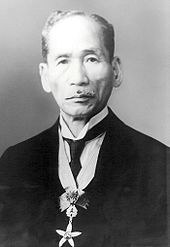Suzuki Umetaro
Suzuki Umetarō ( Japanese 鈴木 梅太郎 ; * April 7, 1874 in Horinoshinden (now part of Makinohara ), Shizuoka Prefecture ; † September 20, 1943 in Shinjuku , Tokyo Prefecture ) was a Japanese pioneer of vitamin research .
Suzuki, the son of a farmer, studied at the Faculty of Agricultural Engineering of the Imperial University of Tokyo from 1893 first agriculture and then (agricultural) chemistry and then in Germany (with Emil Fischer ) and in Switzerland. On his return he became a professor at the Imperial University in Tokyo. In 1932 he was elected a member of the Leopoldina .
He is best known for discovering thiamine (vitamin B1). The Dutch military doctor Christiaan Eijkman had discovered in 1897 that rice bran could cure beriberi- like polyneuritis in chickens and a competition arose among scientists to isolate the responsible substance from rice bran. This was achieved by Suzuki, who patented the process for isolating rice bran. He also correctly classified the substance under the essential nutritional components (later called vitamins). He named the substance aberic acid (and later oryzanine ) and presented his results to the Tokyo Chemical Society in 1910 (published in their journal Tokyo Kagaku Kaishi in 1911). At that time, however, beriberi was mainly attributed to a bacterial infection and his work was ignored, even when it was published in German in 1911. What was lost in the translation was that he classified the substance as an essential nutritional component. It only attracted attention when the Polish chemist Casimir Funk also extracted the substance from rice bran in 1912 and coined the term vitamin for it.
He was also active in vitamin research in today's Riken Vitamin KK, where he isolated vitamin A from fish oil. In 1943 he was awarded the Japanese Order of Culture for his services . He died in the same year in the University Hospital of Keiō University in Tokyo.
He married the daughter of Tatsuro Kingo, who was a professor of architecture in Tokyo.
Fonts
- U. Suzuki, T. Shimamura, S. Odake: About oryzanine, a component of rice bran and its physiological significance, Biochemische Zeitschrift, Volume 43, 1912, pp. 89-153
- Suzuki Umetaro: Kenkyu no kaiko, Tokyo: Kibundo Shobo 1943
Individual evidence
- ↑ Member entry of Umetaro Suzuki at the German Academy of Natural Scientists Leopoldina , accessed on February 25, 2017.
- ↑ James Bartholomew, The Formation of Science in Japan, Yale University Press 1989, p. 172
literature
- S. Noma (Ed.): Suzuki Umetarō . In: Japan. An Illustrated Encyclopedia. Kodansha, 1993, ISBN 4-06-205938-X , p. 1489.
Web links
| personal data | |
|---|---|
| SURNAME | Suzuki, Umetaro |
| ALTERNATIVE NAMES | 鈴木 梅太郎 (Japanese) |
| BRIEF DESCRIPTION | Japanese chemist |
| DATE OF BIRTH | April 7, 1874 |
| PLACE OF BIRTH | Horinoshinden now part of Makinohara , Shizuoka Prefecture |
| DATE OF DEATH | September 20, 1943 |
| Place of death | Shinjuku , Tokyo Prefecture |
